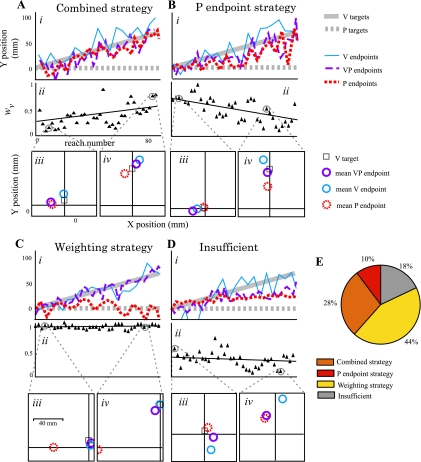Fig. 4.
Individuals used different strategies in experiment 1. When visual-proprioceptive alignment is perturbed and vision is constrained to be the “good” modality, subjects compensate by weighting vision heavily, shifting P reach endpoints in the direction of the perturbation, or both. A: subject who used a combined weighting and P endpoint strategy. i, Targets and reach endpoints in the adaptation block. V targets (solid gray line) were gradually displaced from P targets (dashed gray line) in the positive y direction. This displacement applied to both V and VP targets and reached a maximum of 70 mm by the end of the 84 reaches. V endpoints (solid blue line) tended to follow V targets. Because endpoint visual feedback was given only for VP targets, VP endpoints (dashed purple line) approximate the subject's success: if VP endpoints closely followed the V component of the target (solid gray line), subjects were scoring more points. This subject was 79% “successful.” A change in the position of P endpoints (ΔŷP = 57.4 mm, dotted red line) suggests that proprioceptive realignment may have taken place, but motor adaptation of the reaching hand could also have contributed. ii, wV in the adaptation block. A separate wV value was calculated for each VP reach. The line represents the best fit but was not used in any calculations. This subject relied more on vision by the end of the adaptation block (wV = 0.55). iii and iv, Example wV calculations. wV was calculated by comparing the mean of three VP endpoints (purple circle) to the means of the four V endpoints and four P endpoints (blue and red circles) occurring closest in time. Two-dimensional distances were used. P targets were at the origin. iii, It is apparent that early in adaptation (fourth wV is illustrated in this case), VP endpoints are closer to the P estimate than the V estimate, reflecting a high weight of proprioception and low weight of vision. iv, The situation was reversed later in adaptation (second-last wV is illustrated in this case). B: subject who used the P endpoint strategy alone. i, P endpoints shifted substantially during adaptation (38.2 mm). Success was 66%. ii, However, vision was down-weighted, and the subject relied more on proprioception by late adaptation (wV = 0.29). C: subject who used the weighting strategy alone. i, No P endpoint shift in the direction of the misalignment occurred (−7.3 mm, not significantly different from zero; P > 0.4 by rank sum test). Nonetheless, success was 79%, because vision was weighted heavily throughout (late adaptation wV = 0.94; ii). D: subject who did not use either strategy. i and ii, Little P endpoint shift took place (9.9 mm; i), and the subject did not rely heavily on vision (late adaptation wv = 0.30; ii). This subject had limited success (44%). E: group data (n = 39 subjects). For the purpose of dividing subjects into categories, we counted P endpoint shift ≥ 35 mm as using the P endpoint strategy and late adaptation wV ≥ 0.5 as using the weighting strategy.

